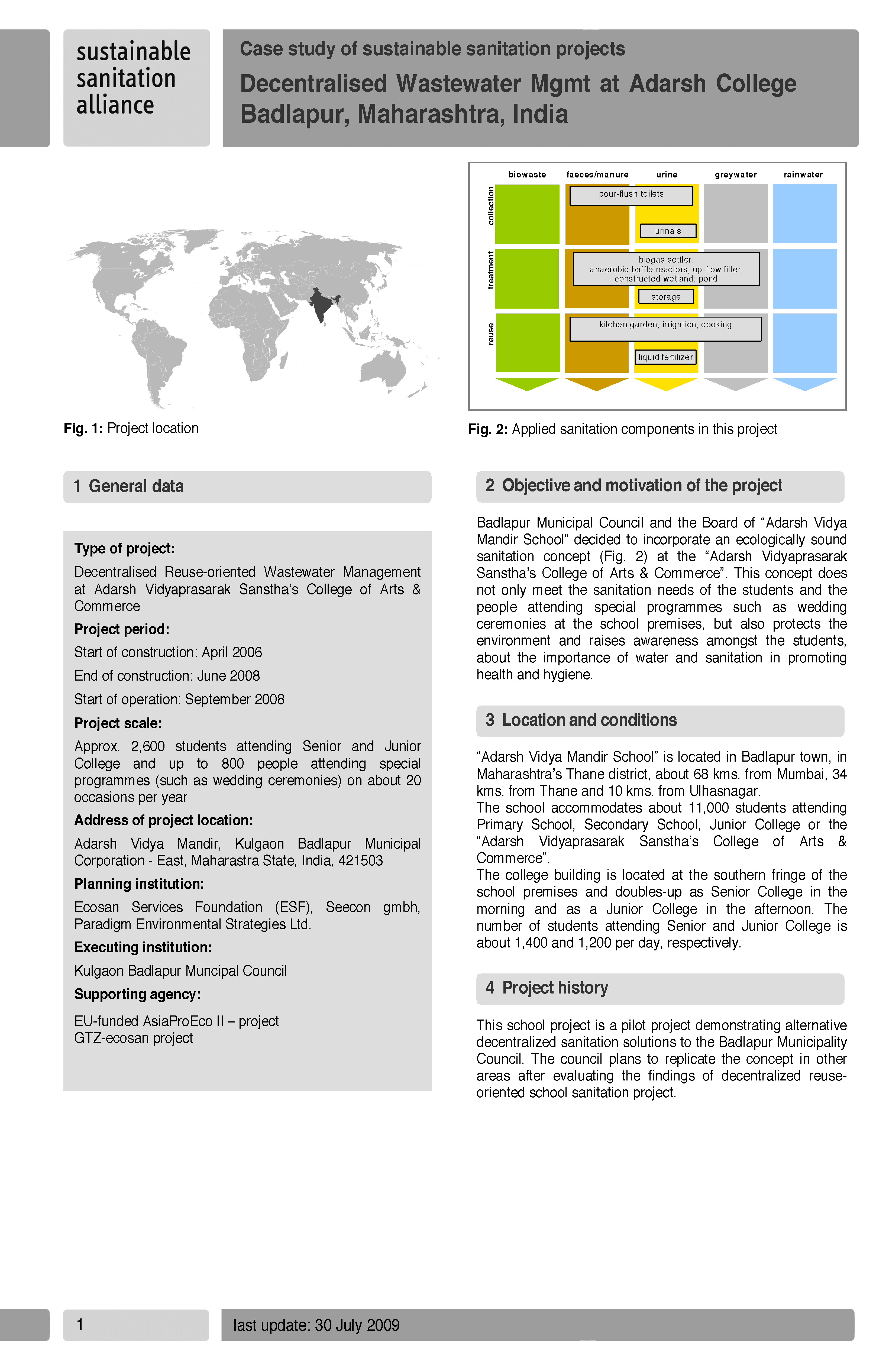Decentralised wastewater management at Adarsh College Badlapur, Maharashtra, India - Case study of sustainable sanitation projects
Zimmermann, N., Wafler, M., Thakur, P. (2010)

Published in: 2010
Publisher:
Sustainable Sanitation Alliance (SuSanA)
Author:
Zimmermann, N., Wafler, M., Thakur, P.
Uploaded by:
SuSanA secretariat
Partner profile:
common upload
16335 Views
530 Downloads
Location of library entry
Content - Summary
This case study discusses the decentralised reuse-oriented wastewater management project at Adarsh Vidyaprasarak Sanstha’s College of Arts & Commerce, India. The project serves 2,600 student and other beneficiaries who visit the school on several occasions.
The prime objective of the project is to meet the sanitation needs of the students and the people attending special programmes. In addition, it shall protect the environment and raise awareness amongst the students about the importance of water and sanitation in promoting health and hygiene. This school project is a pilot project demonstrating alternative decentralized sanitation solutions to the Badlapur Municipality Council. The council plans to replicate the concept in other areas after evaluating the findings of decentralized reuse-oriented school sanitation project.
A single-storied sanitation block having two independent enclosures for ladies and gents has been constructed next to the school building. Each enclosure is equipped with 4 bucket-flush squatting-type toilets and 1 western-style cistern-flush pedestal (for the physically challenged). Waterless urinals are provided in the gents’ toilet block, while the ladies’ toilet block has an increased number of toilets. Sufficient numbers of washbasins are provided in each toilet block. Blackwater along with greywater from the washbasins is discharged to a “biogas settler”. Its effluent is drained by gravity flow to an Anaerobic Baffled Reactor (ABR) and Up-flow Filter (UF) for further anaerobic treatment. Post treatment of the UF effluent happens in a small-scale horizontal flow constructed wetland (HFCW). The final stage of the treatment concept is a pond that doubles-up as storage tank. Treated water and urine will be used in a yet to be established kitchen garden. Sludge drying beds will be constructed for dewatering the sludge from the biogas settler, baffled reactor and up-flow filter. The produced biogas will be used either for cooking or lighting purpose. The dried sludge from the biogas settler, baffled reactor and up-flow filter will be applied as soil amendment within the school premises for agricultural/gardening purposes.
Students attending environmental classes will be involved in the monitoring of the treatment system and practise the reuse of recycles in the kitchen garden. With regards to long-term impacts of the project, the main expected impact of the project is improved sanitation, demonstration of substitution of LPG by biogas, and the safe reuse of the treated water for irrigation purposes.
Bibliographic information
Zimmermann, N., Wafler, M., Thakur, P. (2010). Decentralised wastewater management at Adarsh College Badlapur, Maharashtra, India - Case study of sustainable sanitation projects. Sustainable Sanitation Alliance (SuSanA)
Filter tags
Biogas systems Case studies in SuSanA template Constructed wetlands East Asia & Pacific English Urban (entire city) Urine















